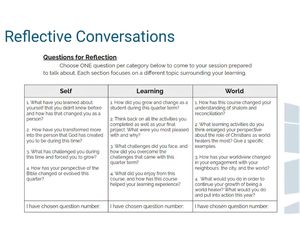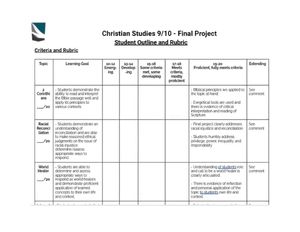As Bible teachers, we often feel ambivalent about grading. We wonder, should Bible class even be assessed? I’ve asked guest author Julia Vanderveen to share her journey in, out, and back again to renewed appreciation of assessment. You will find that Julia’s broad experience gives her a powerful perspective! –Heidi Dean, CSI Bible Specialist
We have tremendous privilege in the classroom—in the regularity with which we see students, the time and space that is provided, and the accountability we have with students. These factors create the most amazing platform for learning, character formation, and spiritual formation, but it’s something I took for granted the first time I was teaching. After several years in pastoral work, I returned to teaching with a renewed appreciation for classroom tools like assessment.
Here are eight practices on grading and assessment that I have come to embrace.
1. Reframe Assessment as Mentorship
When I started teaching twenty years ago, I went in with all these ideas of what I should do, what assignments I should give, and then one week into school, the Twin Towers fell. Of all the tasks required at that time, marking seemed to be one of the most trivial. Students were feeling vulnerable and needing mentorship in the classroom. I taught for only two years, and while I loved it, trying to grade work for 175 students was an ongoing challenge. My values in mentorship didn’t seem to align with the expectations of grading and instruction. Still, when I went into graduate Christian studies to explore some of the questions that were being raised in the classroom, I thought I’d be back to teaching in two years, but instead I went into campus ministry and then co-pastoring a church.
After several years, I began to realize I was ready to head back to the classroom. One turning point was when I was teaching an adult Bible study. A participant was giving a summary of what she thought the passage was about, and I suddenly had the urge to give a more formal type of assessment and say, “Can you go back and redo that?”
I now think of assessment as a conversation. In fact, the word assessment is derived from the Latin word assidere meaning “to sit with.” To assess is not necessarily to quantify and rank student output but to “sit with” in a mentoring posture. At Vancouver Christian School, our goal is to provide continuous feedback on patterns of learning rather than only gathering numeric grades to represent a student’s “output.”
2. Focus on Proficiency
We want to teach with our big-picture goals in mind: the formation of faithful, informed, Christ-centered students. But sometimes when we turn to creating assignments and assessing, we lose sight of our big-picture goal.
British Colombia has asked educators to mark in terms of “proficiency in skills,” so the language used across K–12 is the language of “emerging, developing, proficient, or extending” one’s skills. I appreciate this model and think it is transferable because it keeps the “big Ideas” at the top of the rubric with content and competencies underneath.
It helps us remember that we’re not looking for only content mastery (though we are) but also for how students are internalizing skills in other ways. This provides some rich possibilities and gives us space for a mentoring posture.
3. Use Group and One-on-One Conversations
It can be hard to make the time for one-on-one conversations, but I have found it worth to carve out a significant amount of time, such as 2.5 hours in one afternoon to talk with each student in class. These one-on-one conversations have proven very fruitful for personal mentoring. I had a class with several students who were failing to meet expectations but after the one-on-one, every student turned in 100 percent of their work.
We also reflect and hear feedback as a group, not only one-to-one. With each assignment, I make sure I write at least one positive comment, even if it needs to go into the “redo” pile. I also bring up comments in class as a way of intentionally following up: “Nicholas, what you wrote was so touching, and I appreciate that. You showed a lot of empathy.”
This feedback cultivates a community dynamic and an ongoing conversation, rather than just leaving a number. At the end of every course, I also have a final reflective conversation with a small group of four students. They come prepared by having thought through the reflection questions in advance. This conversation has been very rich, and students love it. They have put a lot of thought into it and been vulnerable, and it’s been one of my highlights.
4. Blend Content with Creativity
We love to read Scripture and to invite students to respond creatively. They annotate their copy of the text and then we ask them to respond through a poem, a prayer, or another creative mode.
Another of my favorite assignments is diagram summaries, inspired by the BibleProject. Students read the whole book, cover to cover, and they are then asked to summarize the whole book on one blank sheet of paper. We have four categories of assessment: Content, Themes, Structure, Presentation & Style. We’ve found that when students deeply encounter Scripture and the Spirit is at work in their hearts, they find ways to internalize and express it, and their work always looks different from one another. Many students said this was the best way for them to understand what this book was all about.
5. Assess Skills of Exegesis
Students are provided with a number of skills in how to read the Scriptures. They then choose a passage and, using a template, explore what they were led to: layers of historical-cultural context, lexical considerations (a word students), and then meaningful application. The students’ work on this exceeded my expectations.
6. Structure a Project of Sustained Inquiry
Students are coached to formulate an overarching question to guide their research and exploration of our book (2 Corinthians), and we asked them to tie in certain themes and throughlines that our school is using. Our theme is world-healers, so we wanted students to interact with that. We provide a structure to help them explore their overarching question through three sub-topics. Students must then decide how they’re going to present this, and it is wide open. They could create a website, a magazine, a painting, a poetry anthology, a movie, a song, a scrapbook, a composition—anything that communicates their findings in an effective, creative, and meaningful way. The rubric is flexible enough to fit any of them. (See resource included with this article.)
7. Use a Single-Column Rubric
Rubrics can become overly complicated with too many factors to analyze. I suggest keeping it simple through a single-column rubric. Only the “proficiency” column contains text, listing the standards for proficiency. The other columns are left blank so that we can write in them as needed to show students specific ways their skills are either “emerging” (not yet proficient) or “extending” (going beyond expectations). I have found this to be a simple, clear, and effective style of rubric.
8. Incorporate an Authentic Audience
When possible, it is terrific to incorporate a real-world project involving an audience outside the school. Our school was given a donation by a philanthropist, so we’ve been involving student conversation in what we should do with the donation. We’re not grading any of this, but the students are loving the conversations about how to best steward this resource we’ve been given. What would the impact be if we gave it to this organization? What if we ourselves turned it toward this purpose? How would it best benefit the recipients?
If you are interested in hearing Julia’s full breakout session from the 2021 CSI Bible Instruction Symposium, where she shows samples and rubrics throughout, check out CSI’s Catalyst community. Your membership fee of $14.99 provides access to a range of resources, including all recordings from the 2021 CSI Bible Instruction Symposium!
About our guest author: Julia Vanderveen (MDiv, Regent College) is campus pastor and Christian Studies teacher for grades 9–12 and has previously worked in university and congregational contexts. She and her husband, Trevor, live in Vancouver, BC, with their three school-age boys. Julia values collaborative teaching and enjoys the task of aligning the new BC proficiency scale for assessments with the values of Christian education.

Julia Vanderveen looks at assessment through the lens of mentorship.

The Vancouver Christian School staff have come to clearer, shared approaches to assessment through weekly collaboration and transparency in lesson planning.

Reflective Conversations Rubric
Rubric for Reflective Conversations (J. Vanderveen)

Student Outline and Rubric
Rubric for Final Project of Sustained Inquiry (J. Vanderveen)